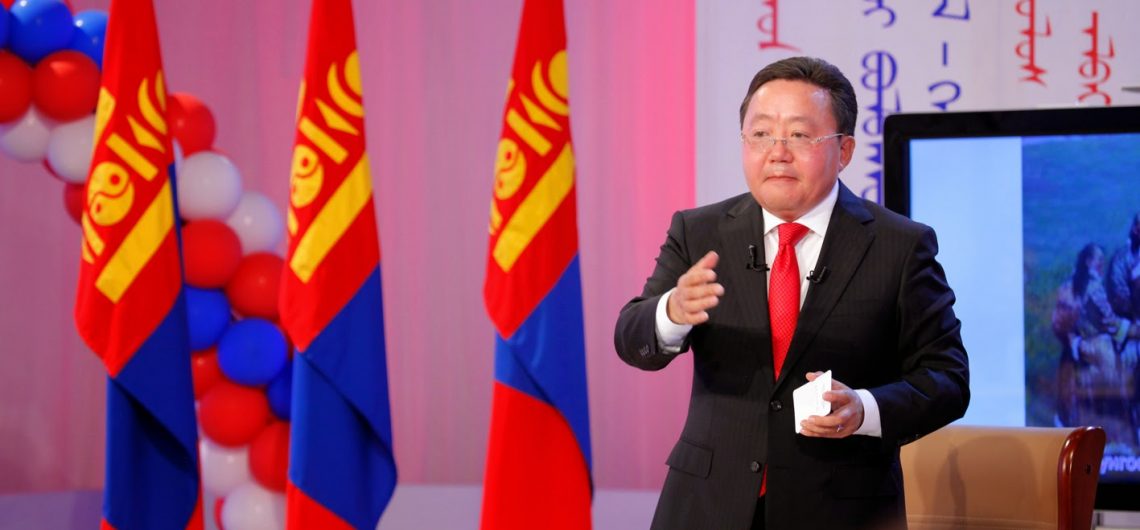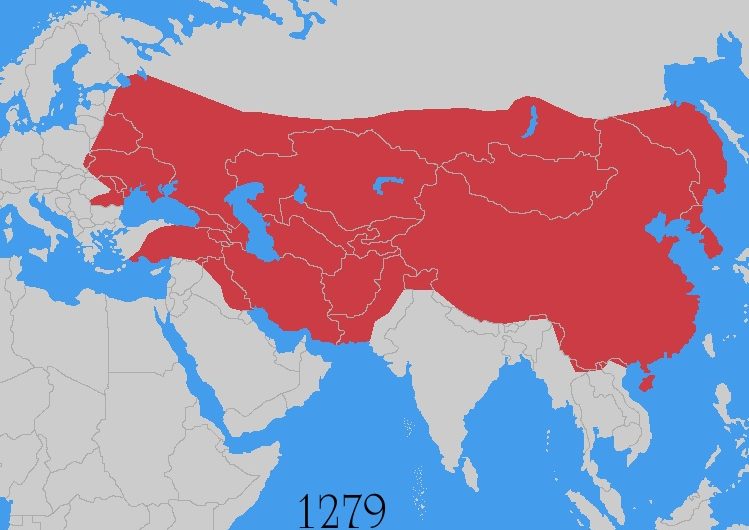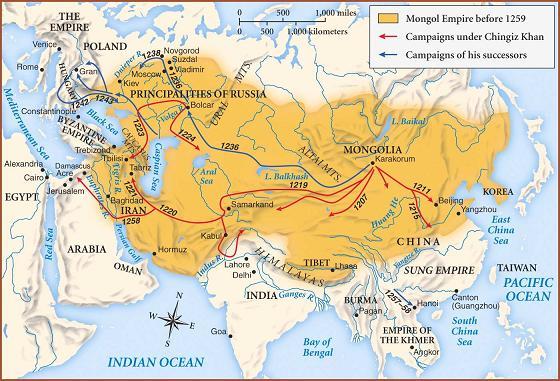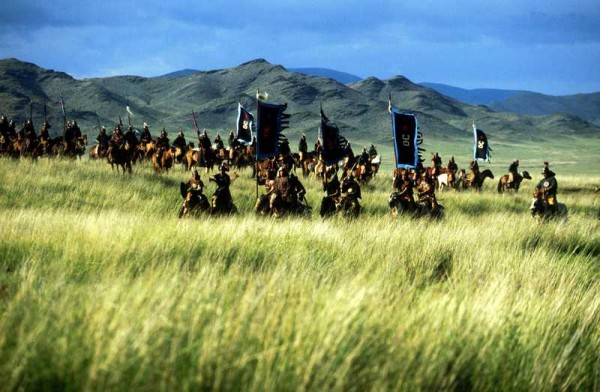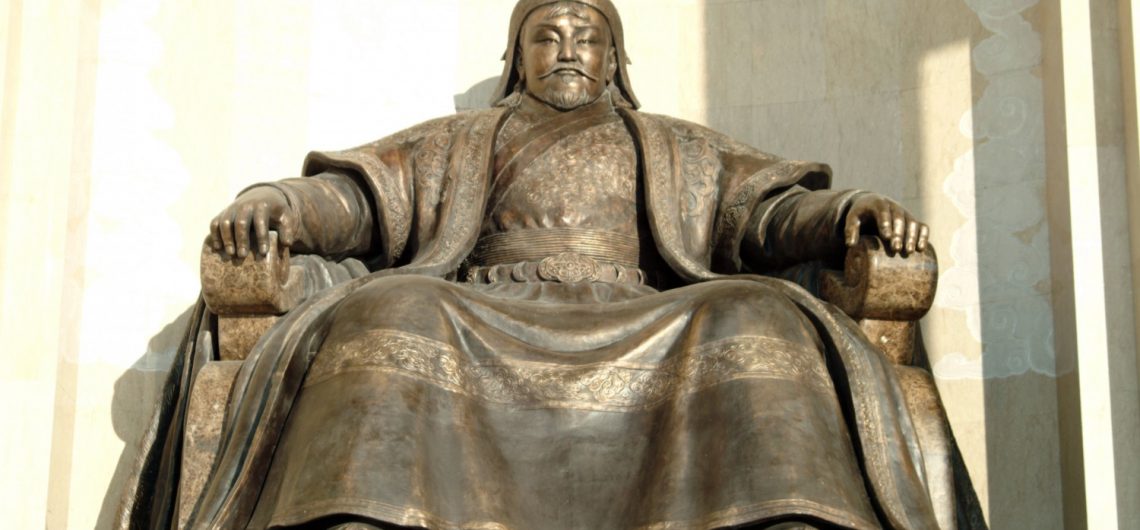First men appeared in Mongolia 500.000 years ago. This is a chronology retracing the main events occurred in Mongolia throughout its history.
Prehistoric period
500.000 BC: humans appear in Mongolia
4000 BC – 2000 BC: Bronze Age
2000 BC: breeding develops in Mongolia
700 BC – 500 BC: transition towards the beginning of Iron Age
400 BC: Chinese people starts to build the Great Wall to protect themselves from any incursion of the Xiongnus, main enemies of China
Xiongnus and Mongolian empires
209 BC: Modun Shanyui establishes the first Mongolian empire: Xiongnu Empire
1 – 100: Xiongnus are driven out of China
156: Xianbeis defeat the Xiongnus. Xianbei Empire becomes the most important empire of Central Asia.
317: Xianbeis conquer North China
360: end of the Xianbei Empire
386 – 533: period of the Wei Dynasty, established by the Tuoba in North China
745 – 840: period of the Uyghurs’ reign. They had defeated the Kokturks in 744.
840: Kyrgyz seize control on Uyghurs
916: beginning of the reign of Kitans, established beyond East Mongolia, Manchuria and North China
1122: Chinese defeat Kitan
The Great Mongol Empire
1162: Temujin’s birth
1189: Temujin becomes the famous Emperor Genghis Khan
1189 – 1205: Genghis Khan unifies the Mongolian nomadic tribes
1206: Genghis Khan proclaims himself leader of the Mongol Empire and begins to found his empire
1211: Genghis Khan attacks China
1215: Beijing is defeated and becomes Mongolian
1227: Genghis Khan’s death
1229: Genghis Khan’s third son, Ogodei Khan, is proclaimed second Khan
1231: Invasion of Korea
1235: Kharkhorin becomes the capital of the Mongol Empire. Marco Polo arrives in Kharkhorin right at that time.
1236 – 1240: period of offensives against Russia by Genghis Khan’s grandson, Bat Khan, and his Golden Horde
1241: Ogodei Khan’s death
1241 – 1242: Mongols invade Poland and Hungary
1246: Guyuk, Ogodei’s son, is proclaimed Khan and subdues Tibet. He dies this year.
1247: Mongolia has its first census
1251: Ogodei’s nephew, Mongke, is proclaimed Khan
1251: Mongols defeat Iran
1254: William of Rubruck arrives in Kharkhorin, Franciscan monk sent by the King Louis IX of France
1256: Mongols take Bagdad
1259: Mongke’s death
1260: Egyptian Mameluks defeat Mongols
1261: Genghis Khan’s grandson, Khubilai Khan, is proclaimed Grand Khan
1264: the capital is moved to Beijing
1271: Khubilai Khan changes the name of his empire into “Yuan”
1274 and 1281: Mongols try to invade Japan, without success
1275: Marco Polo reaches China
1276: Mongols annex Hangzhou, capital of the Song’s China
1279: Khubilai Khan achieves the conquest of the Chinese territory unifying China in his own empire. He founds the Yuan Dynasty overthrowing the Song Dynasty of South
1294: Khubilai Khan’s death
1299: Mongols invade Syria
1333: Togoontomor, last Khan of the Mongol Empire, seizes control on the Yuan Empire
1368: Mongols lose the Chinese territory. The Yuan Dynasty collapses and is replaced by the Ming Dynasty

Fall of the Empire, domination of Manchus
1388: Chinese destroy Kharkhorin
1400 – 1454: civil war in Mongolia
1409 – 1449: Mongolia attacks China
1466: Dayan Khan unifies most Mongolian tribes
1480 – 1502: end of the control of Mongols on Russia. The Golden Horde falls.
1571: Mongols put an end to a 300-year war against Chinese
1578: Mongols convert to Tibetan Buddhism under Altan Khan’s reign. He gives the title of Dalai Lama to Sonam Gyatso.
1586: Buddhism becomes the official religion of Mongolia
1589: the construction of the first monastery of Mongolia begins: Erdene Zuu Monastery.
1641: Zanabazar is proclaimed leader of Buddhism in Mongolia
1641 – 1652: Russians defeat Buryats and win back the control of the area of Lake Baikal
1672: Mongolia invades Siberia and Russia
1691: Most Khalks Mongolians accept the Manchu sovereignty and are included in the Chinese Empire (Qing Dynasty, 1644-1911)
1728: the Sino-Russian treaty of Khyakhta redefines the Mongolian borders
1732: end of the independence of Mongolia with the defeat of the Dzungars
1750: China divides Mongolia into two parts: North becomes Outer Mongolia and South becomes Inner Mongolia
1783: Russians defeat the last reigning descendent of Genghis Khan
Independence, socialism and democracy
1 December 1911: Outer Mongolia becomes independent from China
28 December 1911: Mongolia puts in place an autonomous theocratic government
5 November 1912: a Sino-Russian treaty recognises China’s sovereignty on Mongolia
25 May 1915: Russia, China and Mongolia sign the treaty of Khyakhta that guarantees the independence of Mongolia
September 1918: Chinese troops occupy Outer Mongolia
March to June 1920: first steps towards the creation of the Mongolian People’s Party that forges links with the international communist movement
October 1920: White Russians invade Mongolia
13 March 1921: creation of the Mongolian People’s Party
July 1921: the Russian and Mongolian armies drive the White Russians out of Mongolia
11 July 1921: creation of the Provisional Popular Government of Mongolia
14 September 1921: Sukhbaatar, hero of the Revolution, announces the independence of Mongolia
5 November 1921: Soviets recognise the Provisional Popular Government
22 February 1923: Sukhbaatar’s death
31 May 1924: A Sino-Russian treaty recognises China’s sovereignty on Mongolia
August 1924: the Mongolian People’s Party becomes the Mongolian People’s Revolutionary Party
25 November 1924: communists announce the Mongolian People’s Republic. The capital is named Ulaanbaatar (Ulan Bator in English), “red hero” referring to Sukhbaatar
December 1928: Khorloogiin Choibalsan becomes the political leader
1929 – 1932: confiscation of the feudal goods and abolition of the religious communities
27 November 1934: an agreement between Mongolia and Russia authorises the entry of Soviet troops in Mongolia
1937 – 1939: religious purges
1938: closure and destruction of Buddhist monasteries
1939: Khorloogiin Choibalsan becomes an uncontested leader
1939: the Russian and Mongolian troops defeat Japanese in East Mongolia
March – April 1940: Yumjaagiin Tsedenbal becomes secretary-general of the party
10 August 1945: Mongolia declares war on Japan
5 January 1946: China recognises the independence of Mongolia
27 February 1946: signature of the Treaty of Friendship and Mutual Assistance about economic and cultural cooperation between Mongolia and Soviet Union
26 January 1952: Choibalsan’s death
May 1952: Tsedenbal becomes Prime Minister
December 1952: signature of an agreement about economic and cultural cooperation with China
6 July 1960: new constitution
27 October 1961: Mongolia joins the United Nations
1962: condemnation of the “cult of personality” against Choibalsan
7 June 1962: Mongolia joins the Council for Mutual Economic Assistance
23 August 1984: Batmonkh becomes secretary-general of the party
12 December 1984: Dumaagiin Sodnom is elected Prime Minister
April 1986: signature of long-term commercial agreement with China
27 January 1987: first diplomatic relations with United States
7 March 1989: Soviets announce the withdrawal of the troops
1992: a new constitution is written and communists win another election
1996: against all odds, the democratic coalition defeats the communists in the legislative elections
2000: turnaround: the communists defeat the democrats in the following elections
